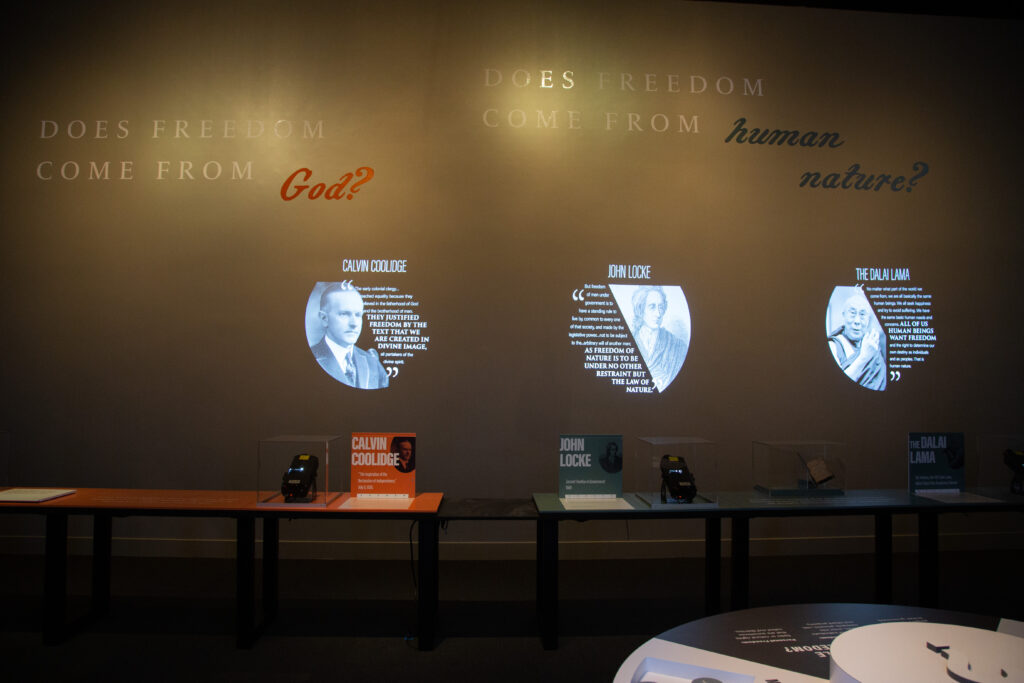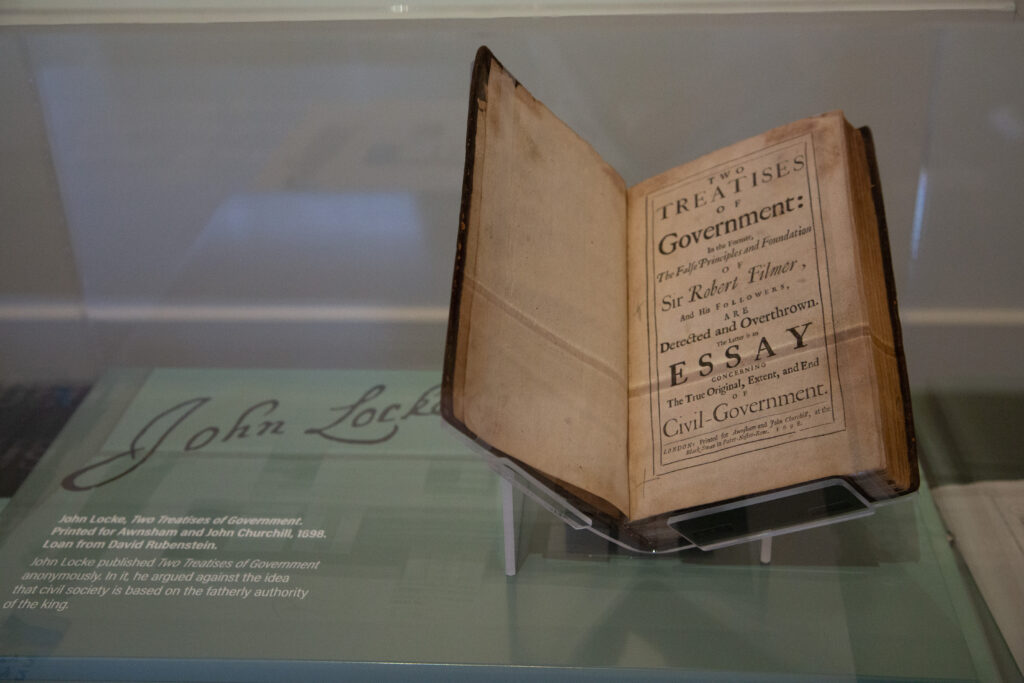Exhibit Gallery Guide
Freedom Matters
Pickles
Plan Your Visit
This is some of the best copy I’ve ever seen. It keeps going on, too. Nicely. But not too nicely. Just the right length,.

Freedom Matters uses historical documents and personal perspectives to examine the concept of freedom: where it comes from, what it means, what free societies look like, and the role of the individual in protecting and spreading freedom around the world. It utilizes primary source documents and the words of freedom advocates to guide a journey through history, particularly highlighting times when personal, political, and economic freedom has expanded and contracted for people in the United States.
The exhibit is interactive and multi-sensory, inviting visitors to consider how freedom impacts their life and the lives of others. It builds upon concepts and ideas that demonstrate how, over decades and centuries, an individual’s work can inspire the action of thousands.
Freedom Matters also asks the visitor to consider the role of nuance, critical thinking, and openness to other views and perspectives when examining history and what we can learn from it.
“I believe that freedom is a gift from God and the hope of every human heart. Freedom inspired our founders, and preserved our union through civil war, and secured the promise of civil rights. Freedom sustains dissidents bound by chains, believers huddled in underground churches, and voters who risk their lives to cast their ballots. Freedom unleashes creativity, rewards innovation, and replaces poverty with prosperity, and ultimately freedom lights the path to peace.”
President George W. Bush
Gallery 1
Introduction
Freedom is “the permanent hope of mankind, the hunger in dark places, the longing of the soul.” It is a universal aspiration. Yet the path to freedom is not linear—or inevitable.
History shows that defending freedom is the shared responsibility of free people. Standing up for the meaning and promise of liberty means helping others determine their path, find their voice, and attain freedom. Together, we can light the way to a more just world.
As visitors enter this gallery, they are greeted by the voices of unidentified individuals discussing freedom and why it matters.
As the voices speak, their words are projected on the gallery’s walls one at a time.
Guests will meet these voices again at the end of the exhibit in the final video.
Gallery 2
Defining Freedom
For centuries, thinkers and philosophers have debated what freedom means and where it comes from.
Regardless of where freedom originates, people experience the rights and obligations that accompany freedom in their personal, political, and economic lives.
Gallery 2 defines freedom, introduces visitors to different philosophical perspectives about where freedom comes from, and gives examples of personal, political, and economic freedoms.
This gallery also level sets the foundation upon which the exhibit is built. Because the concepts presented in this gallery are slightly more academic, the gallery is intended to be very interactive.
“Can a person walk into the middle of the town square and express his views without fear of arrest, imprisonment, or physical harm? If he can, then that person is living in a free society. If not, it’s a fear society.”
Natan Sharansky, former Soviet dissident
Artifacts in this Gallery:
- John Locke, Two Treatises of Government. Printed for Awnsham and John Churchill, 1698. Loan from David Rubenstein.
- Jean-Jaques Rousseau. A Treatise on the Social Compact; Or The Principles of Politic Law, 1764. Loan from David Rubenstein.
Gallery 3
Securing Freedom
Gallery Three: Securing Freedom
People form governments to structure society, ensure safety, and secure justice. Democratic governments aim to protect the political, economic, and personal freedoms of the individual. Democracies follow the rule of law.
Authoritarian governments limit the rights of their citizens in order to maintain control.
The Magna Carta
King John of England was highly unpopular. He lost British land, taxed his subjects heavily, and made an enemy of the Church.
In 1215, King John was forcibly required by a group of English barons to sign a royal charter of rights called the Magna Carta. The Magna Carta was the first document to state that the king and his government were not above the law.
Two of the most critical clauses in the Magna Carta are still in British law today: Clause 39 guaranteeing due process and Clause 40 establishing that the law applies to everyone — no one is above it.
Artifacts in this Gallery:
- Vetera Statuta Angliae, including the Magna Carta and other Statues of the Realm. Decorated manuscript on parchment, early 14th century. Loan from Harlan R. Crow.
- The Signing Of The Magna Carta, by Francois-Theodore Devaulx, early 19th century. Loan from Harlan R. Crow
Gallery 4
The American Experiment
Gallery Four: The American Experiment
Since its founding over two centuries ago, the United States has sought to become a more perfect union and fulfill the ideals enshrined in its founding documents.
At times, we’ve lived up to that goal. We’ve also fallen short. But in every generation, extraordinary and ordinary Americans have fought for freedom and the rights of others, pushing for change to secure the blessings of liberty for all.
A government of the people, by the people, for the people. That is the American experiment.
Artifacts in this Gallery:
- Printing of the Declaration of Independence, by Peter Force, 1831. This print is one of just 31 remaining copies. Loan from Harlan R. Crow.
- English Bill of Rights. An Act Declaring the Rights and Liberties of the Subject and Settling the Succession of the Crown, 1689. Loan from David Rubenstein.
- The Federalist: A Collection of Essays Written in Favor of the New Constitution, as Agreed upon by the Federal Convention, September 17, 1787. Loan from David Rubenstein.
- “The New Plan for the Federal Government Proposed by the Convention,” The Columbian Magazine, 1787. Loan from David Rubenstein.
- Proposed Amendments, The Journal of the First Session of the Senate of the United States of America, 1789. Loan from David Rubenstein.
- Proclamation of Emancipation by the President of the United States, January 1, 1863. Loan from David Rubenstein
- Narrative of Sojourner Truth. Published for the author by William Lloyd Garrison, 1850. Loan from David Rubenstein.
- Political Debates between Hon. Abraham Lincoln and Hon. Stephen A. Douglas, in the Celebrated Campaign of 1858. Loan from David Rubenstein.
- Uncle Tom’s Cabin; or, Life Among the Lowly by Harriet Beecher Stowe, 1852. Loan from David Rubenstein.
- The Revolution, edited by Elizabeth Cady Stanton and Parker Pillsbury, published by Susan B. Anthony, 1868–1871. Loan from David Rubenstein.
- Woman Suffrage Party pennant. Loan from Harlan R. Crow.
- United States Government reports on relocation and internment, War Relocation Authority. Loan from David Rubenstein.
- Stride Toward Freedom, by Dr. Martin Luther King Jr., 1958. Loan from David Rubenstein.
- Reproduction of Letter from Mrs. E. Jackson in Favor of Voting Rights. Courtesy National Archives and Records Administration.
- Where Do We Go From Here: Chaos or Community? by Dr. Martin Luther King Jr., 1967. Loan from David Rubenstein.
- Reproduction speech cards used by President George H. W. Bush at the signing ceremony of the Americans with Disabilities Act on July 26, 1990.




